 United States Connor D’Netto, Korngold, Brahms: Nicola Benedetti (violin), Los Angeles Philharmonic Orchestra / Simone Young (conductor). Walt Disney Concert Hall, Los Angeles, 28.12.2021. (LV)
United States Connor D’Netto, Korngold, Brahms: Nicola Benedetti (violin), Los Angeles Philharmonic Orchestra / Simone Young (conductor). Walt Disney Concert Hall, Los Angeles, 28.12.2021. (LV)

Connor D’Netto – uncertain planning (2020) (US premiere)
Korngold – Violin Concerto in D major Op.35
Brahms – Symphony No.4 in E minor Op.98
With the music director of the Los Angeles Philharmonic off rehearsing Turandot at the Paris Opera, it was up to Simone Young (the chief conductor of the Sydney Symphony Orchestra) to take the orchestra at its Technicolor best through an effervescent new fanfare by Connor D’Netto, Korngold’s Violin Concerto with Nicola Benedetti (who took the old adage ‘break a string’ literally) and Brahms’s Fourth Symphony.
Korngold’s Violin Concerto has been one of the orchestra’s signature pieces since they premiered it with Jascha Heifetz in 1945. It was the composer’s homage, perhaps, or an attempt at recapturing the old Vienna: as he wrote it, his beloved city was being destroyed by Nazis and bombed by the Russian army. It may have been written for a virtuoso of almost military might, but Benedetti revealed how deeply Korngold had tapped into the romantic passion he had written for the love scenes between Errol Flynn and Olivia de Havilland in The Adventures of Robin Hood and Captain Blood. And it was the elegance, purity and sexual chemistry of their make-believe relationships that Benedetti brought to bear with the silvery tone of her 1717 Gariel Strad. The woodwind colors popped out, and the brass combined with the strings in broad romantic swells that sometimes overwhelmed the soloist, but she stood her ground and toned down Korngold’s most incongruous flourishes; never hesitated at digging into all the usual technical acrobatics; took special relish at The Devil and Daniel Webster (Bernard Herrmann) bits in the finale; and broke a string.
It was 90 seconds or so after Benedetti tore into the last movement – at a pace and drive that took even Young and the orchestra by surprise – that the tuning peg on her E string became loose. Young slowed the orchestra down and stopped them like police do traffic on the freeway, Benedetti quickly tightened the peg, retuned and, with a brief nod to Young and her colleagues as if to say ‘Okay, let’s get on with it!’, took off where she had stopped. (Members of the string section reported that because it was very dry, many of them had experienced the same issue and needed to retune suddenly.)
The American premiere of Connor D’Netto’s splashes of color called uncertain planning started the concert. There were amazing sounds from all the instruments indiscriminately, including a massive percussion array, some serious aleatoric stuff and a solo French horn off stage (in this case in the organ loft high above the stage). Commissioned by the Sydney Symphony Orchestra’s 50 Fanfares Project, the work seemed to rouse both audience and orchestra out of any lethargy they might have been feeling, and to get them ready for the more seductive colors of the Korngold.
Representing a search for ‘systems to carve out imagined spaces with sound, [as] a broken world continued to turn outside my window and the uncertainty outside inevitably spread in’, D’Netto’s eight minutes of often-violent outbursts was greeted with cheers. And the precise yet unleashed nature of the performance may have been authoritative: uncertain planning had been premiered this past February (alongside Dvořák’s ‘From the New World’ Symphony) by the Sydney Symphony Orchestra – conducted by Simone Young.
In Brahms’s Fourth Symphony, Young and the orchestra emphasized the music’s breadth and warmth, and shaped the usual rhetorical flourishes passionately but without stopping much to breathe or look for miracles. The Allegro giocoso was very fast and punchy, the second subject lovely and contemplative; and while the finale’s passacaglia forged intrepidly ahead with some lovely playing, Young never found a basic tempo that could serve as the foundation for a larger arc.
Laurence Vittes
